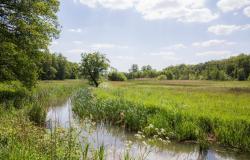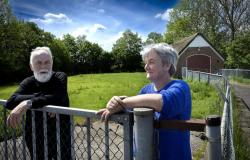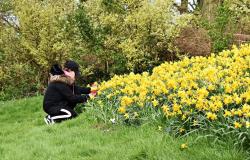If you are an Olympic champion in Tokyo, you have to fight for your salary. The situation of Kiran Badloe provides a good insight into how fragile the (financial) life of a Dutch top athlete is. The wind foiler still enjoys the A status of the sports association NOC*NSF and therefore receives a basic salary, but three years after Badloe’s gold medal, the money from the water sports association mainly goes to Luuc van Opzeeland, the big contender in France. Badloe still wants to go to the European Championships, but currently has no coach and no program.
“Everything depends on that little bit you get to pay your rent or mortgage and food. If that disappears, you have to become very creative,” Badloe said last year A.D. “I think there should be a different construction. Many athletes would benefit greatly from more certainty. They perform better without the pressure of: if I don’t do it now, I will have to stop.”
The only problem is: there is no more financial space in the top sports country of the Netherlands. Less than a hundred days from the Games in Paris, where the Netherlands is expected to win another record number of medals, several people in top sport are sounding the alarm about the tight budget. Problems that arise at all levels at the top. There is not enough money to reward the absolute top performers. Guaranteeing the livelihoods of athletes is a concern. And facilitating the growth of young talent, in order to maintain the medal supply, is also becoming an increasing challenge.
Get out and make way
“We will really be short of money in the near future,” says André Cats, technical director of NOC*NSF. “We are in an extremely inflation-sensitive world. Tickets, hotels, salaries. Everything becomes much more expensive. More athletes are also coming to us to say: we are also worth supporting. We would also like it if we could add a number of sports to TeamNL, but that requires money.”
Cats previously said that an additional €20 million is needed annually to keep top sport in the Netherlands at the same level. NOC*NSF receives 65.6 million euros annually from the Ministry of Health, Welfare and Sport. In addition, there are contributions from the Dutch Lottery (16 million) and the IOC and partners (2.2 million). But despite all those flows of money, it recently became clear that things are structurally squeaking and creaking.
Plenty of examples. The Olympic prize pool has been reduced due to increased premiums for the Paralympians, which are recovered from the multiple medal winners. In the meantime, there is uncertainty as to whether there will even be a prize pool for the 2026 Winter Games in Milan. Dutch athletes competing in Paris can arrange two tickets per match for friends and family, but must purchase them themselves at cost price. And in the Olympic village in Paris, TeamNL apartments are being rotated at a rapid pace. Once you have finished exercising, it’s time to leave and make room. Measures that cause misunderstanding among athletes.
Vital society
“We are stuck because we are so successful, we have more medal winners than money,” says Joop Alberda, the golden volleyball coach in Atlanta in 1996, later technical director at NOC*NSF and the Athletics Union. Alberda finds it understandable that the limited money from the sports association will no longer automatically go to the greatest champions, such as Sifan Hassan, Harrie Lavreysen and Femke Bol. “They really know how to capitalize on their achievements.”
However, he has been advocating for more appreciation for (top) sports in the Netherlands for years. “Because the other side of this story is that this is a reflection of how we exercise in the Netherlands and give sport a place in society. How valuable do we find it that we inspire society with dozens of medals in a time of lack of exercise and encourage children to exercise? That is disappointing.”
NOC*NSF director Cats also points out the essential role that sport should play in a vital society. “Politics should acknowledge and recognize that. So we are making a broad appeal: be a little proud of the Dutch athletes.”
But should that extra money come from The Hague? From commercial parties? Or from the International Olympic Committee, which pays millions to the (inter)national associations, but still refuses to pay prize money to the athletes who help make the summer games so iconic. “They are supposedly not commercial, but they earn an enormous amount of money from TV money and sponsors,” says athlete manager Jos Hermens. “And the actual artists, the athletes, they get nothing in return. Call it amateurism, or in a big word exploitation.”
Commercial value
World Athletics is the first major sports association to make a change by paying out prize money in Paris and in four years’ time in Los Angeles: $50,000 for the Olympic athletics champions. Such a gesture should not be expected from all Olympic associations, but perhaps this will put the IOC on the spot and prize money will become a permanent fixture at the Games in the future.
The Dutch Sports Council recently presented an advisory report on a future-proof organization and financing of top sport entitled The setup at the top. It emphasizes in sixty pages that the government must value top sport more and ensure more future-proof financing.
Sports marketers Bob van Oosterhout and Patrick Wouters van den Oudenweijer both contributed to the report, as did almost all major sports associations, municipalities and sports organizations. “I think everyone should take a few extra steps. Politics in The Hague, NOC*NSF, the athletes,” says Van Oosterhout, who would like to see more commercial value created around the Olympic athletes. “In Paris we will cheer loudly for Harrie Lavreysen again. Then he is continuously in the picture for two weeks and can’t handle the attention, he is one of the biggest love brands from The Netherlands. But then it collapses very quickly.”
That is why Van Oosterhout is thinking out loud about joining forces with all Olympic athletes, a commercial initiative that makes TeamNL as a whole easier to market. Colleague Wouters has the same in mind. “TeamNL must be relevant 365 days a year. Not just during a European Championship or World Cup or the Olympic Games. When I see an athlete running, cycling or riding somewhere in the country, I immediately have to see: that is a TeamNL athlete. All the same look and feel. The KNVB, KNSB and KNHB are economically independent enough that you could leave them out in the beginning. The rest must rigorously opt for central management of TeamNL and place all rights there. Then it is a hell of a proposition with impact, especially socially. TeamNL can be a huge source of inspiration for youth, to get people moving and make the Netherlands a vital country.”
Part of industry
The problem that many Olympic athletes are largely invisible outside the Games is also often locked up in their sports. Who watches archery outside of the Games? Who sets their alarm for a track cycling World Cup race in Hong Kong? If it is broadcast at all. The less visible athletes should put extra energy into this themselves. Of course, there are athletes who are also stars on social media and have a large following and therefore appeal. But there are also many who live with blinders on and focus all their focus on the sport itself.
“As a top athlete you have to realize that you are part of a certain industry,” says Van Oosterhout. “If you, as an athlete, say: ‘I have nothing to do with social media’, then you will certainly score a failing grade in the eyes of old-fashioned companies that only look at how often you appear on screen. You have to be prepared to a certain extent to commercially monetize your exposure.”
Sports manager and former athlete Jos Hermens has been fighting for more visibility and commercial value for athletes and athletics with his Global Sports Communication for years. He fully recognizes what Van Oosterhout is saying and calls it too simple to just point to The Hague. According to him, athletes and sports must do much more to become commercially attractive, which he has been trying for years with the NN Running Team around Abdi Nageeye, Nienke Brinkman and many African top runners. They release documentaries, approach the press themselves and radiate unity in a sport of individuals.
One fist
“It is the question that concerns me most: how do we increase the pot of income for the athletes?” says Hermens, who agrees that Dutch sports performance is going great, but that this exceptional status is now at stake. “We are victims of our own success in the Netherlands. The top players can eventually make ends meet, but what really matters is whether there is a basis for boys and girls who dream of reaching the top at the age of eighteen. I’m not worried about the football players or tennis players, but Olympians in the less professionally organized sports are really having a hard time. There is hardly any money in a wonderful sport like judo and we see for ourselves how difficult it is for Harrie Lavreysen in track cycling. We have now been able to find good sponsors, but that was not easy.”
That is precisely why Van Oosterhout and Wouters say: join forces as ‘small’ sports, make one fist together. “A lot of positive things have happened in the last five years. Odido and the Dutch Lottery are great partners. But there is much more to this proposition,” Wouters believes. “It needs to have more of a face. There is now too much deliberation and compromise. Associations and athletes find it difficult to give up their own position and rights because they are not sure what the benefits will be. But if everyone participates as much as possible, all Olympic associations, you have one of the most valuable propositions in the Netherlands, perhaps worth 25 million euros per year or more.”
And that extra money is desperately needed, NOC*NSF director Cats knows. “At a certain point you have to wonder whether our top 10 ambition can remain intact if those investments do not materialize. That sounds like a threat, but we are already sailing close to the wind. We must not fall below the lower limit.”
Tags: long Netherlands remain top sports country medal winners money
-





